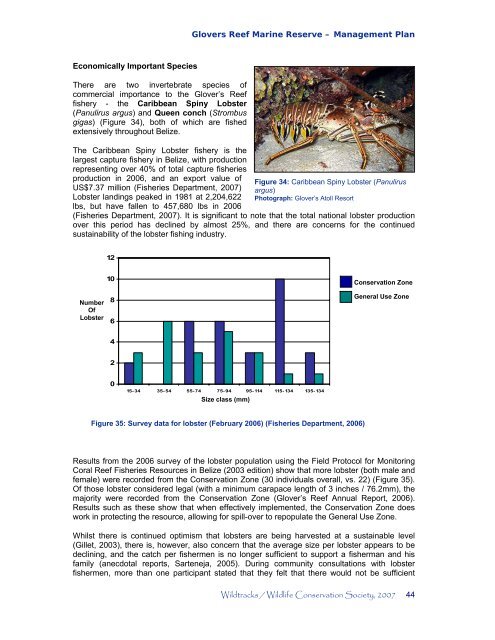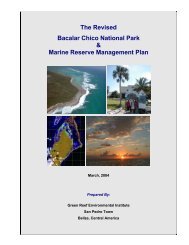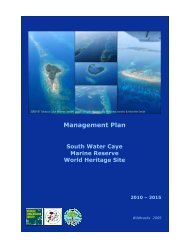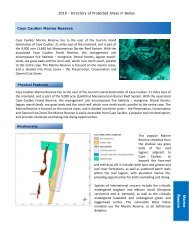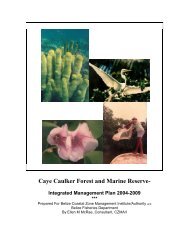Management Plan - Glover's Reef Marine Reserve
Management Plan - Glover's Reef Marine Reserve
Management Plan - Glover's Reef Marine Reserve
Create successful ePaper yourself
Turn your PDF publications into a flip-book with our unique Google optimized e-Paper software.
Economically Important Species<br />
There are two invertebrate species of<br />
commercial importance to the Glover’s <strong>Reef</strong><br />
fishery - the Caribbean Spiny Lobster<br />
(Panulirus argus) and Queen conch (Strombus<br />
gigas) (Figure 34), both of which are fished<br />
extensively throughout Belize.<br />
The Caribbean Spiny Lobster fishery is the<br />
largest capture fishery in Belize, with production<br />
representing over 40% of total capture fisheries<br />
production in 2006, and an export value of<br />
US$7.37 million (Fisheries Department, 2007)<br />
Lobster landings peaked in 1981 at 2,204,622<br />
lbs, but have fallen to 457,680 lbs in 2006<br />
Glovers <strong>Reef</strong> <strong>Marine</strong> <strong>Reserve</strong> – <strong>Management</strong> <strong>Plan</strong><br />
Figure 34: Caribbean Spiny Lobster (Panulirus<br />
argus)<br />
Photograph: Glover’s Atoll Resort<br />
(Fisheries Department, 2007). It is significant to note that the total national lobster production<br />
over this period has declined by almost 25%, and there are concerns for the continued<br />
sustainability of the lobster fishing industry.<br />
Number<br />
Of<br />
Lobster<br />
12<br />
10<br />
8<br />
6<br />
4<br />
2<br />
0<br />
15-34 35-54 55-74 75-94 95-114 115-134 135-134<br />
Size class (mm)<br />
Figure 35: Survey data for lobster (February 2006) (Fisheries Department, 2006)<br />
Conservation Zone<br />
General Use Zone<br />
Results from the 2006 survey of the lobster population using the Field Protocol for Monitoring<br />
Coral <strong>Reef</strong> Fisheries Resources in Belize (2003 edition) show that more lobster (both male and<br />
female) were recorded from the Conservation Zone (30 individuals overall, vs. 22) (Figure 35).<br />
Of those lobster considered legal (with a minimum carapace length of 3 inches / 76.2mm), the<br />
majority were recorded from the Conservation Zone (Glover’s <strong>Reef</strong> Annual Report, 2006).<br />
Results such as these show that when effectively implemented, the Conservation Zone does<br />
work in protecting the resource, allowing for spill-over to repopulate the General Use Zone.<br />
Whilst there is continued optimism that lobsters are being harvested at a sustainable level<br />
(Gillet, 2003), there is, however, also concern that the average size per lobster appears to be<br />
declining, and the catch per fishermen is no longer sufficient to support a fisherman and his<br />
family (anecdotal reports, Sarteneja, 2005). During community consultations with lobster<br />
fishermen, more than one participant stated that they felt that there would not be sufficient<br />
Wildtracks / Wildlife Conservation Society, 2007 44


